Z390 Motherboard Preview: Gigabyte, MSI and ASRock Tested
Initial Findings and Final Thoughts
Since Intel won’t yet allow us put numbers to its latest CPU models, we’re only going to discuss how these boards compared to each other and to their predecessors using the same CPU. You’ll get the digits in our full reviews.
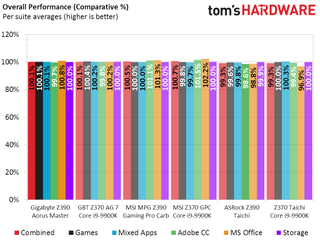
Most of the performance of Intel’s platforms is contained within the CPU, so we didn’t expect to see any consistent dominance by the new chipsets. Furthermore, the new motherboards are still green enough that we expect each one of them to receive noticeable firmware improvements in the coming weeks and months. So keep in mind the performance you see here might not exactly match what you'll get from an updated board later in 2018 and beyond.
Power Handling and (Over)heating
The best reason to pick one of the new Z390 boards over its predecessors might be that the voltage regulator cooling is designed for eight-core processors, at least at stock speeds. We found that every board needed direct fan cooling at the voltage regulator to overclock, but also found that every Z370 board needed direct fan cooling simply to run our eight-core processor at stock speed. We still got the CPUs hot enough to get an approximate full power reading, however.
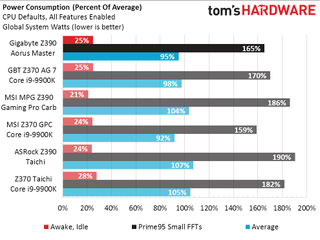
The elder MSI Z370 Gaming Pro Carbon was the only board that could never receive enough cooling to sustain the new CPU at stock settings, even though it used a slightly lower core voltage to reduce power draw, and even after we stepped up to a 158CFM fan blowing directly over it. While most manufacturers view Prime95 small-FFTs as unrealistically harsh for real-world stability testing, we believe that a rating of 100% stability requires us to get as close to a 100% load as possible.

That means the above temperature numbers for the Z370 Gaming Pro Carbon are invalid. Achieving maximum load for a period long enough to reach maximum CPU temperature on the Gigabyte Z370 Aorus Gaming 7 required the addition of an 80CFM fan blowing at a 45 degree angle from approximately 6 inches away. That wouldn’t do for the Z370 Taichi, which required the same 158CFM fan that didn’t fix the Z370 Gaming Pro Carbon’s woes.
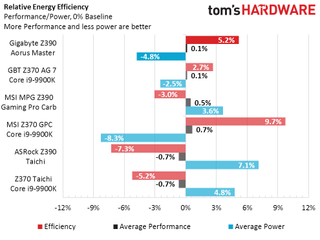
The lower core voltage used by the Z370 Gaming Pro Carbon to preserve its voltage regulator could have made it the most efficient board in these tests, if not for its intermittent throttling after ten or so minutes of being loaded. But those who despise Prime95 as a stability test will probably find reason to argue.
Overclocking …Or Not…
The elder Z370 Aorus Gaming 7's new 8-core firmware doesn't have TjMAX Temperature adjustment, and its default throttle point prevented any overclocking tests. The Z370 Gaming Pro Carbon likewise dropped out of the overclocking test due to voltage regulator overcurrent protection that prevented the it from supporting high frequencies while set to a core voltage greater than 1.25V. The Z370 Taichi reached a 50MHz lower overclock than the newer models from rival brands, due to its voltage regulator overheating despite our addition of a 158CFM fan. And just when you thought that the amperage limits of older boards would allow the newer Z390 boards to dominate, voltage fluctuation in the Z390 Taichi caused it to come up 50MHz short of the Gigabyte and MSI Z390 models. ASRock asked us to use higher core voltage, but doing so put us up against the wall concerning CPU cooling.
Stay On the Cutting Edge: Get the Tom's Hardware Newsletter
Join the experts who read Tom's Hardware for the inside track on enthusiast PC tech news — and have for over 25 years. We'll send breaking news and in-depth reviews of CPUs, GPUs, AI, maker hardware and more straight to your inbox.
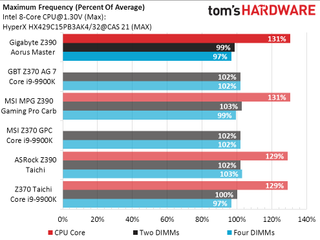
Firmware optimization for various DRAM takes time, so we shouldn’t be too surprised that the previous-generation boards are holding their own against the new ones in this regard. We anticipate that the new processor will support greater data rates as those firmware optimizations are applied, as well.
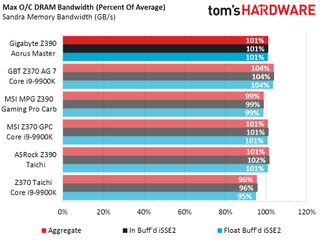
Optimizing for DRAM means getting both improved data rates and improved performance. The elder Z370 Aorus Gaming 7 stands out, and similar developments could put the Z390 Aorus Master ahead as new firmware is released.
Final Thoughts
With the limited headroom afforded most CPUs, most performance enthusiasts don’t even bother overclocking their full-time machine. Today’s all-core overclocks fall in-between the minimum and maximum stock Intel Turbo Boost ratios, so that we only gain performance from fixed-ratio overclocking when more than half of the cores are stressed. It’s important to mention this since so many of our readers already own a Z370 motherboard that can be updated to support Intel’s latest LGA-1151 processors. Those updates have been available for over a month for most boards.

Yet some buyers are upgrading from Z270 or older platforms that won’t support the new CPUs. For them, gradually falling prices might make the Z370 models seem like a bargain. Yet two things that should prevent them from choosing an older board for a newer processor is that existing Z370 boards are likely to arrive without the needed firmware update (which means it won't boot with the brand-new CPUs), and older Z370 boards will be more likely to throttle the CPU when encountering extra-heavy workloads. Updating the firmware will probably require buying or borrowing a previous-generation CPU, and the throttling issue isn’t as easily solvable.
Anyone who already has a Z370 platform and would like to upgrade to an eight-core CPU will probably want to retain that board, update its firmware, and tolerate the potential throttling that might occur when running super-heavy loads over extended periods. It’s not like most of us use our machines to run Prime95 small-FFTs or other similarly demanding software on a daily basis.
But nearly everyone who doesn’t already have a Z370 motherboard will be better off starting with the Z390. And though buyers not in a rush will want to wait a few weeks for the new boards to get improved firmware before even deciding which one to buy, we'll be here testing and pushing out reviews of these new boards as fast as we can.
MORE: Best Motherboards
MORE: How To Choose A Motherboard
MORE: All Motherboard Content
-
g-unit1111 Love that motherboard manufacturers are giving us more options for having a multiple M2 drive configuration. I would love to ditch the mechanical HDs for a fully M2 / SSD setup.Reply -
Crashman Reply
It seems OK now...21385242 said:Sir did you notice putting asrock photo for gigabyte motherboard !
-
Crashman Reply21386421 said:Where's Thunderbolt in that block diagram?
WTF Intel?
Thunderbolt was for the Z170. Thats what the four hidden lanes were supposed to support, but didn't. The Z270 revealed those hidden lanes for use with PCIe or other HSIO devices...so it was probably just a new stepping of the Z170 rather than a redesign. -
njbmw5 Wait a minute... Where's DisplayPort on the Gigabyte Z390 Aorus Master? Wher did it go?Reply -
Crashman Reply
Gigabyte obviously believes anyone paying this much for an enthusiast-market board will not be using the CPU's integrated graphics, so it decreased the number of connectors to one. You can use it for diagnostics. But maybe the one should have been DisplayPort?21387703 said:Wait a minute... Where's DisplayPort on the Gigabyte Z390 Aorus Master? Wher did it go?
-
jpe1701 Can someone explain the difference between integrated WiFi in the z390, and the previous WiFi on Intel boards? What is the advantage of it being integrated into the chipset?Reply -
Crashman Reply
Just cost. Evidently the hardware 1.73Gb/s solution is far more expensive. But practically speaking you'd think they were just shifting the cost from the module to the chipset eh?21389800 said:Can someone explain the difference between integrated WiFi in the z390, and the previous WiFi on Intel boards? What is the advantage of it being integrated into the chipset?
-
jpe1701 Yeah right? I picked one up for my ryzen build and it wasn't any more expensive than the Intel 8260 I bought a couple years ago though. I bought the no v-pro module though.Reply
Most Popular




